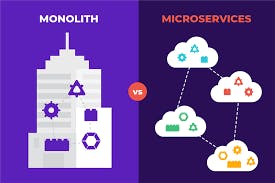Breaking Up is Hard to Do:The Pros and Cons of Microservices vs Monolith

Microservices and monolith architectures are two different ways of architecting software systems. The main difference between them is that microservices are highly decoupled, while monoliths are tightly coupled.
In this article, we’ll go over the advantages and disadvantages of each approach so that you can make an informed decision about which one is right for your project.
Advantages of Microservice Architecture
Scalability: Microservices can be scaled independently, which makes them a good choice for applications that need to handle large amounts of traffic.
Flexibility: Microservices are easier to change and maintain than monoliths because they’re smaller in size, so you can make changes more quickly and easily.
Fault isolation: If one service fails in a microservice architecture, other services won’t be affected by it because they have their own databases and codebases that aren’t shared with other services. This makes it easier for developers to troubleshoot issues when something goes wrong with one of their applications or services (and also helps prevent cascading failures).
Independent deployment: You don’t have to wait until all your code is ready before deploying anything — you can just deploy individual parts of it whenever you want!
Disadvantages of Microservice Architecture
Complexity
The main disadvantage of microservice architecture is the increased complexity. You have to manage and coordinate many different services, which can be difficult to do if you don’t have a good tool or process in place. You also need to think about how your application will scale as it grows, as this might not be something that’s easy for you to do yourself.Communication overhead
Another issue with microservice architecture is that there are more points at which communication between services has to happen than there would be with monoliths (where all code runs within one application). This means that your system may become slower as more people use it because all those connections take time for each request/response cycle; however, if done correctly this shouldn’t cause any major problems unless there are thousands of users accessing your site at once!
Advantages of Monolith Architecture
Monolith architecture has many advantages over microservice architecture.
Monoliths are easier to develop and maintain, as there is one codebase for all the features of your application. This makes it easier for developers to work on a single piece of code instead of having multiple repositories with different languages, frameworks and libraries.
Monoliths also have faster deployment because all components run together in a single process; there is no need for packaging or deployment steps as everything runs on one machine (or virtual machine).
Finally, monoliths are simpler to debug because errors can be tracked down at runtime without having to look at multiple instances of your application running in different processes or containers
Disadvantages of Monolith Architecture
It’s difficult to scale a monolith architecture.
It’s rigid, making it hard to change and adapt over time.
Monoliths are prone to failure because they’re so large that any change can cause problems for other parts of the system.
When to Use Microservice Architecture
Microservices architecture is a good fit for large and complex applications. It’s also ideal for distributed systems, real-time data processing, and microservices with different access or security requirements.
Large and complex applications: Microservice architecture is an excellent choice when you have an application that’s too big to handle as a monolith or if you need to break it down into smaller parts that can be developed independently. This approach allows you to scale each service independently while maintaining loose coupling between them — a key benefit of microservices over monolithic architectures.
Distributed systems: Microservices are ideal for distributed systems because they allow developers to focus on one part of the system at a time instead of trying to understand how everything works together at once (which can be difficult). This makes it easier for them to build reliable software faster than if they were working on a single codebase instead!
Real-time data processing: Because each service has its own database instance, there’s no need for synchronization across those databases like there would be in other types of architectures; this means less overhead during runtime which helps boost performance significantly!
When to Use Monolith Architecture
You should use monolith architecture if:
You have a small and simple application. A monolith architecture is easier to build and maintain than microservices, so it’s a good choice for applications that are small in scope or complexity.
You’re working on a single-team project. In this case, you might not want to split up your team into smaller groups working on different parts of the system; instead, you can keep everyone together in one place and make sure that they communicate well with each other so that there are no gaps in their understanding of how everything works together (or doesn’t).
You’re working on a short-term project — say, less than 6 months long — and don’t expect any major changes after launch time such as adding new features or changing existing ones drastically enough that it would require rewriting large parts of your codebase from scratch again later down the road anyway
Best Practices for Microservice Architecture
Define clear boundaries
Use appropriate technologies
Focus on maintainability
Best Practices for Monolith Architecture
Break down into components
Use appropriate technologies
Focus on maintainability
Conclusion
In this article, we’ve explored the advantages and disadvantages of microservice and monolith architectures. We’ve also looked at some of the key takeaways that you can use to decide which approach is best for your application.